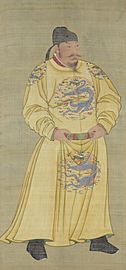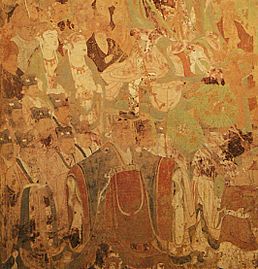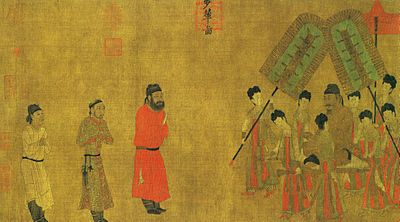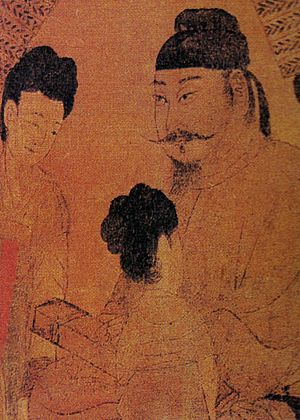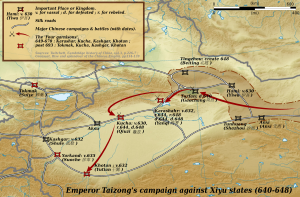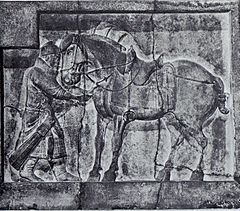Emperor Taizong of Tang facts for kids
Quick facts for kids Emperor Taizong of Tang唐太宗 |
|||||||||||||||||
|---|---|---|---|---|---|---|---|---|---|---|---|---|---|---|---|---|---|
| Huangdi 皇帝 Khan of Heaven |
|||||||||||||||||

Portrait of Emperor Taizong of Tang on a hanging scroll, created during the Ming dynasty era, kept in the National Palace Museum, Taipei, Taiwan
|
|||||||||||||||||
| Emperor of China | |||||||||||||||||
| Reign | 4 September 626 – 10 July 649 | ||||||||||||||||
| Predecessor | Emperor Gaozu | ||||||||||||||||
| Successor | Emperor Gaozong | ||||||||||||||||
| Born | 28 January 598 Qingshan Palace in Wugong, Sui China |
||||||||||||||||
| Died | 10 July 649 (aged 51) Cuiwei Palace in Chang'an, Tang China |
||||||||||||||||
| Burial | Zhao Mausoleum | ||||||||||||||||
| Consorts | Empress Wende (m. 613; died 636) |
||||||||||||||||
| Issue | See § Family | ||||||||||||||||
|
|||||||||||||||||
| House | House of Li | ||||||||||||||||
| Father | Emperor Gaozu | ||||||||||||||||
| Mother | Empress Taimu | ||||||||||||||||
| Tang Taizong | |||||||||||||||||
|---|---|---|---|---|---|---|---|---|---|---|---|---|---|---|---|---|---|
| Chinese | 唐太宗 | ||||||||||||||||
| Literal meaning | "Great Ancestor of the Tang" | ||||||||||||||||
|
|||||||||||||||||
| Qin Wang | |||||||||||||||||
| Chinese | 秦王 | ||||||||||||||||
| Literal meaning | King of Qin | ||||||||||||||||
|
|||||||||||||||||
| Li Shimin | |||||||||||||||||
| Chinese | 李世民 | ||||||||||||||||
|
|||||||||||||||||
Emperor Taizong of Tang (born 28 January 598, died 10 July 649), whose personal name was Li Shimin, was the second emperor of the Tang dynasty in China. He ruled from 626 to 649. Many people consider him a co-founder of the Tang dynasty. This is because he encouraged his father, Li Yuan, to rebel against the Sui dynasty in 617.
Taizong played a key role in defeating many dangerous enemies. He helped make the Tang dynasty strong across China. He is seen as one of China's greatest emperors. His time as ruler, called the "Reign of Zhenguan," was a golden age. It was a time of great success and peace. Future princes had to study his reign as an example.
During his rule, Tang China became very rich and powerful. It controlled most of the land that the Han dynasty once held. This included parts of modern Korea, Vietnam, Russia, Mongolia, Xinjiang, and Central Asian regions. This period set the stage for even more greatness under Emperor Xuanzong.
In 630, Emperor Taizong's general Li Jing defeated the Eastern Turks. This made Tang China the most powerful force in East and Central Asia. Taizong then took the special title of Tengeri Qaghan, meaning "Heavenly Khan" or "God-like Emperor." He also launched campaigns against states in the Tarim Basin and the Western Turks.
Unlike many nobles of his time, Emperor Taizong was a very logical and scientific thinker. He didn't believe in superstitions. He also changed some old traditions to help farmers. His wife, Empress Zhangsun, was also a very helpful and smart partner.
Contents
Early Life and the Sui Rebellion
Li Shimin was born in 598 in Wugong County, which is in modern Xianyang, Shaanxi. His father, Li Yuan, was a general for the Sui Dynasty. Li Shimin showed great talent from a young age. In 613, he married Princess Zhangsun, who was 12 years old at the time.
In 615, when Emperor Yang was attacked by Eastern Turkic forces, Li Shimin joined the army to help. He served with honor. In 616, his father Li Yuan became in charge of Taiyuan city. Li Shimin went with him.
Starting the Rebellion

Emperor Yang of Sui was not happy with Li Yuan. There were also rumors that the next emperor would be named Li. This made Li Yuan worried for his life. Secretly, Li Shimin had already been planning a rebellion with his father's friends.
Li Yuan agreed to rebel and called his other sons and son-in-law to join him. He announced the rebellion, saying he wanted to support Emperor Yang's grandson, Yang You, as the new emperor. Li Shimin and his older brother, Li Jiancheng, became important generals. They marched towards Chang'an, the capital city.
Li Shimin's sister, Princess Pingyang, also started her own rebellion. She gathered a large army and captured several cities. She later joined forces with Li Shimin and her husband. In winter 617, Li Yuan's forces captured Chang'an. He made Yang You the emperor (Emperor Gong) and became the regent. Li Shimin was given the title Duke of Qin.
Fighting Other Warlords
Li Yuan's control of Chang'an was soon challenged by other rebel leaders. One of them was Xue Ju, who called himself the Emperor of Qin. Li Shimin was sent to fight Xue Ju's son, Xue Rengao. Li Shimin defeated Xue Rengao, who was later executed.
In 618, Emperor Yang was killed in a coup. Li Yuan then had Emperor Gong give up the throne to him. This marked the start of the Tang Dynasty. Li Yuan became Emperor Gaozu. He made Li Jiancheng the crown prince. Li Shimin became the Prince of Qin and a top general.
During Emperor Gaozu's Reign
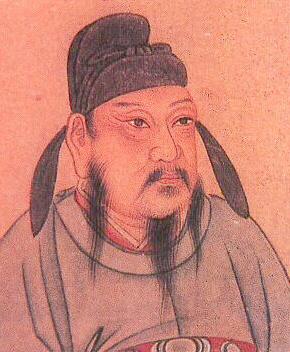
Unifying the Empire
Li Shimin continued to lead armies to unite China. He faced another attack from Xue Ju. Li Shimin used smart tactics to wear out Xue Ju's forces. After Xue Ju died, Li Shimin defeated Xue Rengao, forcing him to surrender.
In 619, another rebel leader, Liu Wuzhou, attacked Tang territory. Emperor Gaozu considered giving up the region. But Li Shimin insisted on fighting. He led the army and defeated Liu Wuzhou's forces. Liu Wuzhou fled, and Tang gained control of the area.
In 620, Li Shimin was sent to fight Wang Shichong, who had started his own state called Zheng. Li Shimin besieged Wang's capital, Luoyang. Wang asked for help from Dou Jiande, another powerful rebel leader. Dou Jiande marched his army to help Wang.
Li Shimin left a small force at Luoyang and moved his main army to Hulao Pass. He defeated Dou Jiande in a major battle and captured him. When Wang Shichong saw this, he surrendered. This brought much of China under Tang control. Li Shimin was greatly rewarded for his victories.
Rivalry with His Brothers
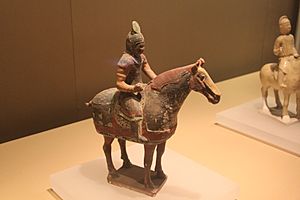
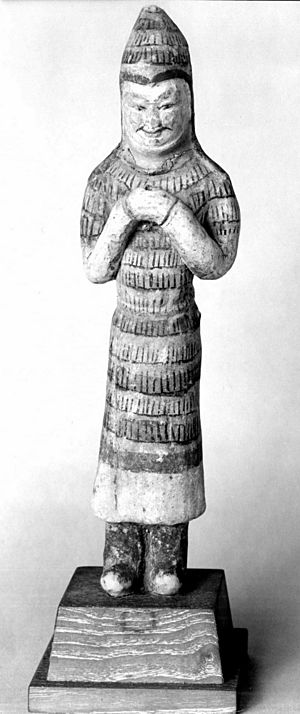
As Li Shimin became more famous, a strong rivalry grew between him and his older brother, Li Jiancheng, the crown prince. Their younger brother, Li Yuanji, supported Li Jiancheng. The court became divided, with officials taking sides.
In 622, Liu Heita, a former general of Dou Jiande, rebelled again. Li Jiancheng, with Li Yuanji's help, defeated Liu Heita. This victory helped Li Jiancheng's reputation.
The rivalry between the brothers grew more intense. Li Shimin feared that Li Jiancheng would try to kill him. His trusted advisors urged him to act first. In 626, the Göktürks attacked again. Emperor Gaozu decided to send Li Yuanji to fight them, giving him control of many soldiers. This worried Li Shimin even more.
The Xuanwu Gate Incident
In summer 626, Li Shimin set a trap at Xuanwu Gate, the central gate to the palace. As Li Jiancheng and Li Yuanji approached, Li Shimin personally shot an arrow that killed Li Jiancheng. Then, Yuchi Jingde, one of Li Shimin's generals, killed Li Yuanji.
Li Shimin's forces entered the palace. Under pressure, Emperor Gaozu agreed to make Li Shimin the crown prince. Li Jiancheng's and Li Yuanji's sons were killed. Two months later, Emperor Gaozu gave up the throne to Li Shimin, who became Emperor Taizong.
Emperor Taizong's Reign
Early Years (626–633)
One of Emperor Taizong's first acts was to send many palace women home so they could marry. He made his wife, Princess Zhangsun, the empress. Their oldest son, Li Chengqian, became the crown prince.
Soon after becoming emperor, Taizong faced a challenge from the Eastern Turks. Their leader, Jiali Khan Ashina Duobi, attacked towards Chang'an. Taizong had to meet him across the Wei River and negotiate peace. He agreed to pay tribute to the Turks to make them withdraw.
Taizong rewarded those who helped him gain power. He also listened carefully to his officials' advice and criticism. He often asked for feedback, especially from Wei Zheng, a trusted advisor. Taizong saw Emperor Yang of Sui as a bad example and wanted to avoid his mistakes. He was also open to different ideas, trying to bring together Taoist and Buddhism beliefs.
In 627, some generals who had supported Li Jiancheng rebelled, but Taizong's forces quickly defeated them. Taizong also reorganized the government, merging many smaller areas into larger "circuits" to make ruling easier.
Defeating the Eastern Turks
By 628, the Eastern Turkic Khaganate was in trouble. Their leaders were fighting among themselves. Many smaller tribes and leaders began to surrender to Tang China. This weakened the Turks even more.
In late 629, Emperor Taizong decided it was time to attack the Eastern Turks. He sent a large army under general Li Jing. The Tang army was very successful. By spring 630, the Eastern Turkic leader Ashina Duobi was captured. All the Eastern Turkic tribes then submitted to Tang.
Taizong decided to let the Turks live within China's borders. This way, they could help defend the empire. He set up new areas for them to live, governed by their own leaders.
Middle Reign (634–641)
In 634, Taizong sent officials to check on local governments. They were to see if officials were doing a good job and if people were suffering. This showed his care for his people.
Campaign Against Tuyuhun
Tang China had problems with the Tuyuhun people, who kept attacking Tang borders. In 634, Taizong sent a large army led by Li Jing to attack Tuyuhun. In 635, Li Jing's forces crushed the Tuyuhun army. Their leader was killed, and his son surrendered. Taizong made the son the new khan, bringing Tuyuhun under Tang influence.
In 635, Emperor Gaozu, Taizong's father, died. Taizong mourned him deeply.
In 636, Empress Zhangsun, Taizong's wife, also died. Taizong was very sad and wrote a special message for her monument.
Tibetan Relations
In 638, the Tibetan king Songtsän Gampo attacked Tang territory. He was unhappy because Taizong had refused to let him marry a Tang princess. Taizong sent an army that defeated the Tibetans. Songtsän Gampo then asked for peace and to marry a Tang princess again. This time, Taizong agreed. In 641, he sent Princess Wencheng to Tibet for the wedding.
In 639, some Turkish princes tried to assassinate Emperor Taizong. After this, officials suggested moving the Turks away from the heart of China. Taizong created a new Eastern Turkic state north of the Great Wall and Yellow River. He appointed a loyal Turkish prince, Li Simo, as their new khan.
Campaign Against Western Turks
Taizong also began campaigns against the Western Turks and their allies in the Tarim Basin. In 640, Taizong attacked Gaochang, a kingdom that had allied with the Western Turks. Gaochang surrendered and was added to the Tang Empire.
Late Reign (642–649)
Succession Issues
By 642, there was a problem with who would be the next emperor. Li Chengqian, the crown prince, feared that Taizong might replace him with his younger brother, Li Tai. This caused a split among government officials.
In 643, Taizong's son Li You rebelled but was quickly captured. During the investigation, it was discovered that Li Chengqian had been plotting to overthrow Taizong. Taizong was shocked. He removed Li Chengqian as crown prince. He also decided to remove Li Tai, believing Li Tai had caused the trouble.
Instead, Taizong chose his younger son, Li Zhi, to be the new crown prince. Li Zhi was seen as kinder and gentler. However, Taizong later worried if Li Zhi was strong enough to be emperor.
Goguryeo-Tang War

In 644, Goguryeo (a kingdom in Korea) attacked Silla, a Tang ally. Taizong decided to prepare for a war to conquer Goguryeo. He gathered a huge army.
In spring 645, Emperor Taizong led his troops towards Goguryeo. Tang forces captured Yodong Fortress and moved towards the Goguryeo capital. Taizong personally led his army to defeat a large Goguryeo force. He then besieged Ansi fortress.
However, the general defending Ansi was very skilled. Tang forces could not capture the fortress. As winter approached and supplies ran low, Taizong had to withdraw. He regretted starting the campaign. He said that if Wei Zheng were still alive, he would have stopped him.
Later Campaigns
After the Goguryeo campaign, the Xueyantuo tribe attacked Tang borders. In 646, Tang generals defeated them. The Xueyantuo leader was killed, and the remaining people surrendered to Tang. Other tribes then offered Emperor Taizong the title of "Heavenly Khan."
In 648, Taizong launched another campaign against Qiuzi, a kingdom in the Tarim Basin. His general captured the king of Qiuzi, bringing the region under Tang control.
Death
By summer 649, Emperor Taizong became very ill. Some believed it was from medicines given to him. He died at his summer palace. His death was kept secret for three days. Then, his death was announced, and Li Zhi became Emperor Gaozong.
Monuments
After making the Tang Empire strong, Emperor Taizong ordered six large stone panels to be carved. These carvings, known as Zhaoling Liujun, showed portraits of his favorite horses. These were the horses he rode during his battles to unite China.
Taizong also wrote poems for each of these six horses. These stone carvings were made between 636 and 649 CE. They show the beauty of early Tang art. They are realistic and powerful.
After Taizong died, these monuments were placed at his tomb complex, called Zhaoling. Four of these stone horse reliefs are now in the Beilin Museum in Xi'an, China. The other two are in the Penn Museum in Philadelphia, USA.
Era Name
- Zhenguan (traditional Chinese: 貞觀; simplified Chinese: 贞观; pinyin: zhēnguàn) 627–649
Chancellors During Reign
| Name | In office | Notes |
|---|---|---|
| Xiao Yu | (626, 627, 630, 643–646) | |
| Chen Shuda | (626) | |
| Feng Deyi | (626–627) | |
| Yuwen Shiji | (626–627) | |
| Gao Shilian | (626–627, 638–647) | |
| Fang Xuanling | (626–643, 643–648) | |
| Zhangsun Wuji | (627–628, 645–649) | |
| Du Yan | (627–628) | |
| Du Ruhui | (628–629) | |
| Li Jing | (628–634) | |
| Wang Gui | (628–633) | |
| Wei Zheng | (629–642) | |
| Wen Yanbo | (630–637) | |
| Dai Zhou | (630–633) | |
| Hou Junji | (630–632, 632–643) | |
| Yang Shidao | (636–643, 645) | |
| Liu Ji | (639–645) | |
| Cen Wenben | (642–645) | |
| Li Shiji | (643–649) | |
| Zhang Liang | (643–646) | |
| Ma Zhou | (644–648) | |
| Chu Suiliang | (644–647, 648–649) | |
| Xu Jingzong | (645) | |
| Gao Jifu | (645) | |
| Zhang Xingcheng | (645) | |
| Cui Renshi | (648) |
Family
Emperor Taizong had many children with his wives and consorts:
- Empress Wende (601–636)
- Li Chengqian, Prince Min of Hengshan (618–645), his first son
- Li Tai, Prince Gong of Pu (620–653), his fourth son
- Princess Changle (621–643), his fifth daughter
- Li Zhi, Gaozong (628–683), who became the next emperor
- Princess Chengyang (630–671), his sixteenth daughter
- Princess Jinyang (633–644)
- Princess Xincheng (634–663), his twenty-first daughter
- Noble Consort, of the Wei clan (597–665)
- Princess Linchuan (624–682), his tenth daughter
- Li Shen, Prince of Ji (629–689), his tenth son
- Noble Consort, of the Yang clan
- Li Fu, Prince of Zhao (634–670), his 13th son
- Consort, of the Yang clan
- Li Ke, Prince of Wu (619–653), his third son
- Li Yin, Prince Dao of Shu (621–667), his sixth son
- Consort, of the Yin clan
- Li You, Prince of Qi (621–643), his fifth son
- Virtuous Consort, of the Yan clan (609–671)
- Li Zhen, Prince Jing of Yue (627–688), his eighth son
- Able Consort, of the Xu clan (627–650)
- Imperial Concubine, of a certain clan
- Princess Yuzhang (621–642), his sixth daughter
- Talented Lady, of the Wu clan (624–705), who later became Empress Wu Zetian
- Princess consort, of the Yang clan of Hongnong
- Li Ming, Prince Gong of Cao (died 682), his 14th son
- Lady, of the Wang clan
- Li Yun, Prince of Jiang (died 674), his seventh son
- Unknown mothers:
- Princess Xiangcheng (died 651), his first daughter
- Princess Runan (died 636), his third daughter
- Princess Nanping (died 650), his third daughter
- Princess Sui'an (died 651), his fourth daughter
- Princess Baling (died 653), his seventh daughter
- Princess Pu'an, his eighth daughter
- Princess Dongyang (died 701), his ninth daughter
- Princess Qinghe (624–664), his 11th daughter
- Princess Lanling (628–659), his 19th daughter
- Princess Jin'an, his 13th daughter
- Princess Ankang, his 14th daughter
- Princess Xinxing, his 15th daughter
- Princess Gaoyang (died 653)
- Princess Changshan, his 20th daughter
See also
 In Spanish: Li Shimin para niños
In Spanish: Li Shimin para niños


